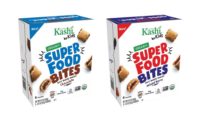Machining and handling of dough prior to the cutting action requires several steps/actions, as they are critical to the textural characteristics of the finished product. Using a formula such as a saltine (fermented), straight or chemically leavened cracker dough as an example—usually referred to as a lean dough due to the low ratio of fat and sugar to flour—the dominant characteristic of these doughs is that they can be rolled out and reduced in thickness by passing through a series of reduction rollers. The formed dough sheet is extensible and may be stretched without breaking or crumbing.
The process starts with depositing the dough mass into the hopper where it is machined into a thick slab of dough. If the dough is properly mixed with the right amount of water, fat and lay time designed into the formula and process, the dough sheet should be uniform with no large holes or ragged edges. Laminating the dough into several layers—four to eight—prior to hitting the cutting machine contributes considerably to the flakiness of the cracker.
At this point in the process, most production lines return the unused dough/scrap (sometimes called sheeter lace) created during the cutting phase to the bulk dough hopper. The re-incorporation of this dough can cause problems, as this scrap has been machined (which toughens the dough) and is at room temperature, which affects the fresh dough machining characteristics. Distribution of this return scrap should be uniform across the dough hopper/laminator sheet to minimize or prevent machining problems.
There are two distinct types of laminators: horizontal and vertical. Horizontal laminators are the most common in baking. These laminators require extensive floor space. Vertical laminators use less floor space and might be more adaptable to plant layouts. Both accomplish the same purpose: creating a dough sheet that is lapped upon itself with a sweep arm depositor.
Another style, the cut-sheet laminator, cuts individual slabs of dough and stacks them on the conveyor belt. Some manufacturers prefer the cut-sheet style, as it reduces variation in dough mass at the edges of the dough sheet, thus reducing weight variations in the dough sheet and finished product.
The number of layers or folds (laps) depends on the particular product being run and the experience with the product. The lapped or layered dough travels at 90o angles through the cutting machine to a series of gauge rollers. The normal amount of gauge rollers is three sets, but much depends on the product. The basic principle underlying all this machining is to create a layered texture, and if a series of laminations are built, it follows that further reduction must be gradual. A conservative rule of thumb is that the reduction ratios should not exceed 2:1. A 3:1 ratio is not excessive, but the greater the ratio, the more work and stress that is put into the dough, which might adversely affect the textural qualities of the finished cracker.
The final action before running to the cutting machine is the use of a relaxation table. After the extensive directional sheeting of the dough, it will have a tendency to recover. If the sheet is cut with this dough stress/tension still present, the crackers might shrink in the direction of travel. Compounding this shrinkage is the heat of the oven. Packaging issues may arise when round crackers are oval or square crackers are rectangular. To reduce this effect, a relaxation transfer belt is run at a slower speed, which removes the directional stresses in the dough sheet. Once the tension/stress is reduced, the dough sheet is then transferred to the cutting apron to feed the cutting rolls or reciprocating cutter.
Understanding the sheeting process leads to a products that are more uniform in size, texture and consistency. The American Bakers Association will be releasing an Intermediate Level Training module on sheeted crackers in the coming months. If you have an individual who wishes to gain further knowledge in this area, these programs are spot-on.




